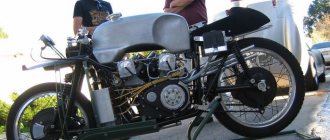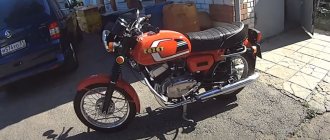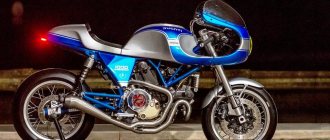Yamaha MT 01
text from Motorreview:Alexander Dmitriev,
photo:
Dmitry Ivaikin
Yamaha MT-01: 1670 cm3, 90 l. pp., 240 km/h, $19,200
The main premiere of the year, the sensation of the Yamaha concern - the concept of the 1999 Tokyo Motor Show, finally embodied in the serial muscle bike MT-01, triumphantly conquers the world. Now it is both in Russia and on free sale.
The motorcycle market is intensifying. If just last year it was problematic to get any of the new products for testing at the beginning of the season - buyers paid for devices that had not yet been imported in batches - but now dealers have ordered plenty of equipment. And, of course, one of the first MT-01 on Moscow soil came into my possession. You should have seen the eyes of my colleagues when, on a fine spring day, I rode up to the editorial office on this unusual motorcycle!
But why did I decide to test the motorcycle myself, upsetting extreme sportsman Zdorov with his passion for riding on different wheels? I’ll tell you what the secret is: Yamaha - the legendary Vmax - for many years was one of my favorite motorcycles, despite its age, this “sledgehammer”, thanks to the light hand of one Russian motorcycle journalist, attracted attention not with its refined handling, which it does not possess, and not crazy 140-horsepower V4; and not even a tiny tachometer, which is simply scary to look at during intense acceleration. I liked the Vmax for its style and charisma - without classification and without competitors, this motorcycle allowed not only to get a thrill, but also to make a corresponding impression. And if the Honda X4 remained in my eyes only an unsuccessful imitation of the “legend,” then Yamaha itself was simply obliged, releasing something similar to the Vmax in appearance, to make this something at least no worse.
Actually, this determined the test program. It is completely incorrect to compare a motorcycle developed 20 years ago (albeit released in 2005) with a modern one, however, I decided to test the Vmax: still, see in what direction progress is moving, and at the same time refresh my impressions about it an unusual motorcycle. I took it after the MT test, and therefore all my attention was on the new product.
Target group Who is the MT-01 consumer? Looking at the price tag, approaching $20,000 (with a light set of factory tuning), assessing the absence of the ever-fashionable painted plastic and the predominance of neutral-dark tones in the color scheme, it becomes obvious that this stylish device was not created for young people. Rather, for sophisticated consumers who are not fooled by vulgar forward flows and coloring in the “chess player” style. This means that he must have the appropriate qualities - ease of control and necessarily some kind of “zest” for the brightness of his character. After all, if everything is always correct, obedient and pliable, then there is nothing to say. Is not it?
Although, after reading a dozen tests in foreign magazines, I still didn’t understand why the new motorcycle, developed over 8 (!) years, was remarkable. An engine with a transmission taken from the Road Star Warrior (test in Motor Review No. 3, 2004) and slightly modified to boost it, a modern chassis that gives the device almost 100% obedience - cannot be compared with the rebellious Vmax... And nothing specific. "It should not be!" — with this thought, I rolled the motorcycle out of the service center so that I could begin to figure out what was what. It’s incredibly easy to roll it by hand—with a blindfold, the device can be confused with a “400.” You feel the comfort of the steering wheel before you even sit in the saddle. However, the main impression is not even from lightness, but from the dashboard, more precisely from the tachometer, which occupies about 90% of its area. This dial reminded me of both a ship's clock and... a scooter's speedometer - with a red sector starting with the number 55. And what kind of number is this - either km/h, or rpm ´ 100?.. Vibration as the main component
The injection engine runs smoothly even without warming up. It is mounted rigidly in an aluminum alloy frame, unlike the Warrior where rubber mounts isolate it. And if so, then please choose your parking place carefully: at idle, colossal vibrations are dampened only by the tires, the deformations of which are noticeable to the eye. If you increase the gas to 30 on the tachometer, the motorcycle will crawl along the plane on which it stands. Have you ever seen phones with vibration alerts falling from slightly inclined shelves? Unfortunately, the sound produced by the two large mufflers doesn't match the powerful vibration; It seems that the “voice” of the engine was suppressed with a reserve - for those times when motorcycles will be banned altogether.
I start moving (this can be done without gas), in general, I can’t say that the ease of control was very surprising. Of course, the sharp steering geometry, wheelbase of 1525 mm and a greatly reduced center of gravity are simply bound to make even a heavy thing almost weightless. A miracle did not happen: the MT steers no more difficult than the YBR125, but requires attention to the right handle. Yes, the torque of 150 Nm, 90% of which already occurs at 1,500 (!) rpm, forces you to be careful. Otherwise, carelessly adding gas in a section with reduced tire adhesion to asphalt will cause slipping. On good dry asphalt it does not slip, but actively accelerates. It seems that the center of gravity is not only low, but also shifted forward - there is no excessive "goatiness" that would be quite obvious to see here, to the frustration of some.
But there is something else. Having become accustomed on fast and dynamic motorcycles, to which MT unconditionally applies, to holding the “gas” in the zone approaching the peak of torque, I quickly learned that this “number” would not work on the new motorcycle. Accelerating in each gear to 4,000 rpm, before the next shift I felt such a vibration that not only did the image in the rear-view mirrors blur, but the sharpness in my eyes was also lost. The license plates of the surrounding cars seemed blurry to me at such moments.
Is it necessary to emphasize that the red sector of the tachometer with 5,500 rpm and the five-speed gearbox are simply obliged to make the gears stretched. And if on the “Dnepr”, on which I drove tens of thousands of kilometers in my time, such a characteristic was only frustrating (the 650 cc boxer still pulled weakly), then here it gives the motorcycle a very unusual character. The uneven operation of the large “V-shape”, passing through a rigid transmission (at least the main gear was a belt!), is directly transmitted to the drive wheel. Such a pulsation of torque should theoretically interfere with turns taken with a deep inclination (just don’t remember about sportbikes with V2 - they still have 1.7 liters and a camber angle of 48°). In reality this does not happen. Turns the motorcycle neutrally without forcing you to exert any force. Of course, the rather rigid connection of the throttle handle with the rear wheel brings the advantage of the latter into the dialogue between the driver and the motorcycle, forcing it to be taken into account, but at the same time it shows that the MT is still for a sophisticated user.
Turn after turn Of course, after the city, the Moscow Ring Road and the winding roads of the near Moscow region, one is tempted to test the motorcycle on an empty highway, try how to ride it for 50 kilometers without stopping at a uniform speed limit. At first I decided to accelerate to the maximum. And despite all my strong desires, I couldn’t. “I turned it up” to 200 km/h, which corresponds to 4,500 rpm in top gear, and “blown away”. The strong headwind and vibration simply forced me to slow down. Alas, the aerodynamics of a classic motorcycle, which is also narrow, does not fit well with my 70 kg curb weight and windage. While accelerating, I carefully monitored the handling on the straight line: the unloading of the front wheel is barely felt after 180 km/h. In general, the MT adequately perceives active control up to this speed - maneuvers and lane changes do not cause any difficulties. It’s difficult to say further - the integral helmet presses into the face too painfully. And it’s stupid to think about a shield on this motorcycle - it’s even less appropriate here than a saddle on a cow. As a result, a comfortable maximum speed is 130 km/h. By the way, cars overtaking every now and then are not at all annoying. The feeling of reserve torque for almost instantaneous acceleration and power sufficient to reach a speed of well over 200 km/h is still pleasant.
Having ridden those same 50 km, I came to the conclusion: riding the MT further is not a pleasure and the nearest dacha is perhaps the longest recommended trip on this motorcycle. Unless, of course, the road passes through a couple of mountain serpentines, for which it is ideal. MT is not interesting on a straight line. The last statement has been tested in practice. In an effort to improve the quality of the magazine, we occasionally test different approaches to photography. So, this time we tried a new, very long-focus lens (it zooms in a lot). While the photographer was looking for the right angle, I drove along an S-shaped section of the road 800 meters long for an hour and a half without stopping: turn, right turn, left turn, turn - on the tenth approach you lose count of the maneuvers. The most interesting thing is that I wasn’t tired at all! So, a little fatigue - I haven’t skated this season yet - nothing more! The first time I sympathized with the photographer, who was running around the fields with a heavy camera, and not the photographer with me. During these simple exercises, I noticed another positive feature of the MT - it does not need much space to turn around. On a standard two-lane road - in one step, without taking your feet off the pegs and without sliding onto the dusty side of the road.
On the way back, I was a little discouraged by the fuel consumption: a 15-liter tank was enough for 140 km, which after a simple arithmetic operation shows an impressive consumption of 10.8 l/100 km. And this despite the fact that I drove faster than 150 km/h only once and for only a few kilometers.
Returning the motorcycle to the dealer, I caught myself thinking that during the 200 km that I drove behind the wheel of the MT-01, I could not fully understand it, which can be given as a big plus. One more thing is noticeable: with the perfection of the chassis and excellent brakes (for the first time on a large-scale “stripped” motorcycle with radial caliper mounts), the engine with its comfortable mode in the range of 1800-3500 rpm looks like a provocation on the part of the designers. Obviously, in this provocation we must look for why many thousands of future fans will love the new motorcycle or, conversely, these fans will not exist.
Paths of progress Everything is learned by comparison - although I didn’t fully understand the combination of an excellent chassis and an excessively torquey engine, I still got used to it a little. What a surprise it was when, having sat behind the wheel of the Vmax and set off in it, I did not notice where its “16 years” were, or, more precisely, all 20 (we tested a copy from the anniversary series released to the 20th anniversary of the “legend”). I haven’t ridden this motorcycle for five years, and during these years, of course, I forgot much of what determined my attitude towards the motorcycle. Moreover, during this time Vmax managed to acquire another mass of rumors and “authoritative opinions”. This means that many, once driven by the impulse to “saddle” at least something (of course, with more strength and volume “per liter”) and who bought a wonderful motorcycle for only 140 hp. With. (more powerful than the Fireblade!), they couldn’t figure out how to manage it all, they sold it, finally buying sports bikes, and now every company strives to show their erudition by throwing a stone in the direction of a beautiful motorcycle. Forgive me for this lyrical digression.
So, nevertheless, I set off. Yes, the clutch is a bit tight. But checkpoint! I caught myself thinking that I didn’t even notice the difficult search for “neutral” characteristic of the MT - Yamaha, after all. So, the Vmax has an excellent gearbox! Clear switching, easy search for “neutral”... Maybe it’s a limited edition or I came across such a copy (you know, No. 1513 from the two thousandth series, released for the 20th anniversary - with an excellent “box”!), but it’s a fact! Of course, I immediately remembered everything: this narrow steering wheel, the strange “tidy” on the false tank (try to find a real one!) and the engine. After the MT, may its creators forgive me, this V4 seemed perfect. Smooth, uniform and reasonably sufficient traction provides acceleration that the chassis struggles to cope with. A thought immediately arose: a motorcycle with an MT-01 chassis and a Vmax engine would be ideal. Whether the consumer would understand this, I don’t know... Powerful acceleration on the verge of slipping - at 7,000 rpm there is a powerful pick-up, as if a turbine is turning on. I remembered this, but, to be honest, I didn’t expect this. Yes, opening the gas at a speed of more than 100 km/h, looking at the tachometer is not only scary, but also physically difficult - due to acceleration overload. And here you have to look: what’s under the wheels? The 150mm Dunlop Qualifier tire will carry the unlucky fan of “having a blast” into the first ditch if there is even a little sand or a marking line underneath it. No one has yet canceled the guaranteed way to fall, including at Vmax, - to open the “gas” on the separating line. Yes, they love it for this engine, and the chassis is being modernized. With the mandatory installation of a steering damper, without it you feel insecure even on almost flat asphalt. You can forget about uneven roads, especially with longitudinal irregularities - the Vmax feels disgusting on them.
But in the city, in traffic jams, the old-school device felt quite at home, even very good. Although, of course, motorists have difficulty distinguishing its small headlight... This is not a modern “spotlight”.
So, before us are two motorcycles that claim to be chosen. The first is a 1985 model with a dominant crazy engine - imagine what a sensation it was in the 80s! The second is a child of the new century. Perfect handling, only 90 hp. With. and a huge torque, exceeding all reasonable limits, which in certain modes simply interferes with driving. I hope this long-prepared debut will be received by the market. I have already expressed my preference.
Same but different
The simple fact is that the naked bike was based on the latest superbike, and not - like the Suzuki - the previous year's version is still worthy of praise. Yamaha technicians have changed many parts from the R1 engine. New features include the head and camshafts, the crankshaft is heavier, the air chamber has a 2-liter larger capacity, the valves are different sizes, and many of the parts - originally made of titanium - are made of steel in the MT-10. Thanks to these measures, the Crossplane's engine characteristics were better adapted for street use. Power is lower (158 hp), but the maximum is available much faster than in the R1, as is the torque (111 Nm), which is higher in the MT-10 than in the R1.
Brakes are old friends. They are still among the most efficient systems on the market, although the ABS system is simpler than the R-1 system.
The rear sprocket has two more teeth (43) than R1 (41). The wheels are aluminum, not magnesium.
The bottom and mid-range are stronger, which is more necessary every day, but there is no shortage in the top-end regions. What does this mean in practice? Greater engine flexibility, plenty of mid-range power, useful for daily commuting, the occasional burst of throttle, and trouble-free ride on the tires. The MT-10 engine is usually the highlight of the program. The CP4 (Crossplane 4) is an engineering marvel: it runs like a V4, sounds almost like a MotoGP machine and has brilliant performance. The only thing funny is the fact that he doesn’t “pour the collar” (he “drinks” up to 9 l/100 km with “great pleasure”).
Not just a stove
The changes to the R1 aren't just about the engine. MT-10 with fuel weighs 210 kg. This is larger than the R1, although there are no fairings. There is something wrong with the logic here, but this is due to the “impoverishment” of the output package. The MT-10's wheels are aluminum not magnesium, steel tank not aluminum, non-titanium manifolds but steel, etc., etc. This makes the MT weigh more, although 210kg is still a good result . The electronics package is also inferior: the traction control and ABS in the MT-10 are simpler systems than in the R1 (no gyroscopes or IMU metering system), and the display is a regular LCD rather than a color TFT and has inferior features.
So poverty? You can argue and say so, but thanks to this, the MT costs 400,000 rubles less than the R1. The gas is still controlled by wire, and the left paddle shifters have sequential cruise control. The electronics give you a choice of three traction control modes, ABS and - like the MT-09 - three ignition maps. The cards have swapped places: in the MT-10 the strictest and most aggressive reaction to gas is card B, and in the MT-09 it is A.
Crazy on the corners, burning on the highway or terror in the city - the MT-10 will fulfill each of these tasks.
Enough technical details, time to hit the road. The Standard card is the starting point, because already the first attempts at driving in the city on the B card proved that this is not a mode for every day. In the city in B mode the bike clearly gets tired, and the throttle control - due to the rather aggressive response - is almost torture. Why bother? The STD (Standard) handles the city much better in traffic jams, providing control over the agile motorcycle. If it's raining, the softer Map A is a good choice.










